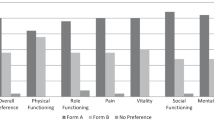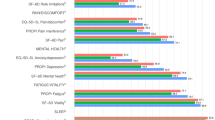Abstract
Purpose
To estimate population norms for the SF-6D health preference (utility) scores derived from the MOS SF-36 version 1 (SF-36v1), SF-36 version 2 (SF-36v2), and (SF-12v2) health surveys collected from a representative adult sample in Hong Kong, and to assess differences in SF-6D scores across sociodemographic subgroups.
Methods
A random telephone survey of 2410 Chinese adults was conducted. All respondents completed questionnaires on sociodemographics and presence of chronic diseases (hypertension, diabetes, chronic rheumatism, chronic lung diseases, stroke, and mental illness), and the short-form 36-item health survey (SF-36) version 1, and selected items of the SF-36v2 that were different from those of SF-36v1. Responses of short-form 12-item health survey (SF-12) were extracted from responses of the SF-36 items. SF-6D health utility scores were derived from SF-36 version 1 (SF-6DSF-36v1), SF-36 version 2 (SF-6DSF-36v2), and SF-12 version 2 (SF-6DSF-12v2) using Hong Kong SF-6D value set.
Results
Population norms of SF-6DSF-36v1, SF-6DSF-36v2, and SF-6DSF-12v2 for the Hong Kong Chinese were 0.7947 (± 0.0048), 0.7862 (± 0.0049), and 0.8147 (± 0.0050), respectively. Three SF-6D scores were highly correlated (0.861–0.954), and had a high degree of reliability and absolute agreement. Males had higher health utility scores (SF-6DSF-36v1: 0.0025; SF-6DSF-36v2: 0.025; SF-6DSF-12v2: 0.018) but reported less problems in all the dimensions than women. Respondents with a higher number of chronic diseases had lower SF-6D scores. Among all respondents with one or more chronic diseases, those with hypertension scored the highest whereby those with mental illness scored the least.
Conclusions
The SF-6D utility scores derived from different SF-36 or SF-12 health surveys were different. The population norms based on these three health surveys enable the normative comparisons of health utility scores from specific population or patient groups, and provide estimates of age–gender adjusted health utility scores for health economic evaluations.




Similar content being viewed by others
References
National Institute for Health and Care Excellence. (2013) Guide to the methods of technology appraisal 2013. London: NICE.
Brazier, J., Roberts, J., & Deverill, M. (2002). The estimation of a preference-based measure of health from the SF-36. Journal of Health Economics, 21(2), 271–292.
Dolan, P. (1997). Modeling valuations for EuroQol health states. Medical Care, 35(11), 1095–1108.
Torrance, G. W., Feeny, D. H., Furlong, W. J., Barr, R. D., Zhang, Y., & Wang, Q. (1996). Multiattribute utility function for a comprehensive health status classification system: Health utilities index mark 2. Medical Care, 34(7), 702–722.
Brazier, J., Deverill, M., Green, C., Harper, R., & Booth, A. (1999). A review of the use of health status measures in economic evaluation. Health Technology Assessment, 3(9), i–iv, 1–164.
Kendall, P. C., Marrs-Garcia, A., Nath, S. R., & Sheldrick, R. C. (1999). Normative comparisons for the evaluation of clinical significance. Journal of Consulting and Clinical Psychology, 67(3), 285–299.
Williams, A. (1999). Calculating the global burden of disease: Time for a strategic reappraisal? Health Economics, 8(1), 1–8.
van den Berg, B. (2012). SF-6D population norms. Health Economics, 21(12), 1508–1512.
Clemens, S., Begum, N., Harper, C., Whitty, J. A., & Scuffham, P. A. (2014). A comparison of EQ-5D-3L population norms in Queensland, Australia, estimated using utility value sets from Australia, the UK and USA. Quality of Life Research, 23(8), 2375–2381.
Lam, C. L., Brazier, J., & McGhee, S. M. (2008). Valuation of the SF-6D Health states is feasible, acceptable, reliable, and valid in a Chinese population. Value Health, 11(2), 295–303.
McGhee, S. M., Brazier, J., Lam, C. L., Wong, L. C., Chau, J., Cheung, A., et al. (2011). Quality-adjusted life years: Population-specific measurement of the quality component. Hong Kong Medical Journal, 17(Suppl 6), 17–21.
Norman, R., Church, J., van den Berg, B., & Goodall, S. (2013). Australian health-related quality of life population norms derived from the SF-6D. Australian and New Zealand Journal of Public Health, 37(1), 17–23.
Fryback, D. G., Dunham, N. C., Palta, M., Hanmer, J., Buechner, J., Cherepanov, D., et al. (2007). US norms for six generic health-related quality-of-life indexes from the national health measurement study. Medical Care, 45(12), 1162–1170.
Ciconelli, R. M., Ferraz, M. B., Kowalski, S., Pinheiro Gda, R., & Sato, E. I. (2015). Brazilian urban population norms derived from the health-related quality of life SF-6D. Quality of Life Research, 24(10), 2559–2564.
Garcia-Gordillo, M. A., Collado-Mateo, D., Olivares, P. R., & Adsuar, J. C. (2018). Chilean population norms derived from the health-related quality of Life SF-6D. European Journal of Health Economics, 19(5), 675–686.
Ferreira, P. L., Ferreira, L. N., & Pereira, L. N. (2015). SF-6D Portuguese population norms. European Journal of Health Economics, 16(3), 235–241.
Shiroiwa, T., Fukuda, T., Ikeda, S., Igarashi, A., Noto, S., Saito, S., et al. (2016). Japanese population norms for preference-based measures: EQ-5D-3L, EQ-5D-5L, and SF-6D. Quality of Life Research, 25(3), 707–719.
Lam, C. L. K., Tse, E. Y. Y., Gandek, B., & Fong, D. Y. T. (2005). The SF-36 summary scales were valid, reliable, and equivalent in a Chinese population. Journal of Clinical Epidemiology, 58(8), 815–822.
Lam, E. T., Lam, C. L., Fong, D. Y., & Huang, W. W. (2013). Is the SF-12 version 2 health survey a valid and equivalent substitute for the SF-36 version 2 health survey for the Chinese? Journal of Evaluation in Clinical Practice, 19(1), 200–208.
Ware, J. E. J. (2000). SF-36 health survey update. Spine, 25(24), 3130–3139.
Government of Hong Kong SAR. (1996) Population by-census. Census and Statistics Department, editor 1997.
Government of Hong Kong SAR. (2016) By-census results 2017 Available from: https://www.bycensus2016.gov.hk/en/index.html.
Government of Hong Kong SAR. (2017) Thematic household survey report no. 63. In: Census and Statistics Department, editor 2017.
Government of Hong Kong SAR. (2017) Mental health review report. Food and Health Bureau, editor 2017.
Funding
Financial support for this study was provided by Health Services Research Committee (HSRC#711026), Hong Kong SAR. The funding agreement ensured the authors independence in designing the study, interpreting the data, writing, and publishing the report.
Author information
Authors and Affiliations
Contributions
CKHW wrote the manuscript, researched data, contributed to statistical analysis, and interpretation of results. BM contributed to interpretation of results and reviewed/edited the manuscript. GC wrote the manuscript, researched data, and contributed to statistical analysis. CLKL contributed to study design, acquisition of data, and reviewed/edited the manuscript.
Corresponding author
Ethics declarations
Conflict of interest
All authors declare that he/she has no conflict of interest.
Ethical approval
All procedures performed in studies involving human participants were in accordance with the ethical standards of the institutional and/or national research committee and with the 1964 Helsinki Declaration and its later amendments or comparable ethical standards.
Informed consent
Informed consent was obtained from all individual participants included in the study.
Electronic supplementary material
Below is the link to the electronic supplementary material.
Rights and permissions
About this article
Cite this article
Wong, C.K.H., Mulhern, B., Cheng, G.H.L. et al. SF-6D population norms for the Hong Kong Chinese general population. Qual Life Res 27, 2349–2359 (2018). https://doi.org/10.1007/s11136-018-1887-3
Accepted:
Published:
Issue Date:
DOI: https://doi.org/10.1007/s11136-018-1887-3




